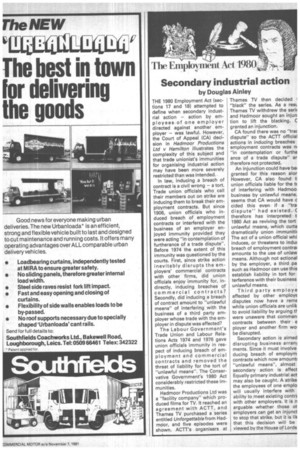The Employment Act 1980 Secondary industrial action
Page 41

If you've noticed an error in this article please click here to report it so we can fix it.
by Douglas Ainley
THE 1980 Employment Act (sections 17 and 18) attempted to define when secondary industrial action — action by emp I oyees•of one employer directed against another employer — was lawful. However, the Court of Appeal (CA) decision in Hadmoor Productions Ltd v Hamilton illustrates the complexity of this subject and that trade unionist's immunities for organising industrial action may have been more severely restricted than was intended.
In law, inducing a breach of contract is a civil wrong — a tort. Trade union officials who call their members out on strike are inducing them to break their employment contracts. But since 1906, union officials who induced breach of employment contracts or interfered with the business of an employer enjoyed immunity provided they were acting "in contemplation of furtherance of a trade dispute". Before 1974 the extent of this immunity was questioned by the courts. First, since strike action inevitably disrupts the employers' commercial contracts with other firms, did union officials enjoy immunity for, indirectly, inducing breaches of commercial contracts? Secondly, did inducing a breach of contract amount to "unlawful means" of interfering with the business of a third party employer whose trade with the employer in dispute was affected?
The Labour Government's Trade Union and Labour Relations Acts 1974 and 1976 gave union officials immunity in respect of inducing breach of employment and commercial contracts and removed the threat of liability for the tort of "unlawful means". The Conservative Government's 1980 Act considerably restricted these immunities.
Hadmoor Productions Ltd was a "facility company" which produced films for TV. It reached an agreement with ACTT, and Thames TV purchased a series entitled Unforgettable from Hadmoor, and five episodes were shown. ACTT's organisers at Thames TV then decided "black" the series. As a rest Thames TV withdrew the seri( and Hadmoor sought an injun tion to lift the blacking. C granted an injunction.
CA found there was no 'Vat dispute" so the ACTT official actions in inducing breaches employment contracts was ni "in contemplation or furthe ance of a trade dispute" ar therefore not protected.
An injunction could have bet granted for this reason alor However, CA also found ti union officials liable for the tt of interfering with Hadmoo business by unlawful means. seems that CA would have c cided this even if a "tra dispute" had existed. C therefore has interpreted t 1980 Act as reviving the tort unlawful means, which curta dramatically union immunitiE The act of a union official whi induces, or threatens to indu( breach of employment contra( amounts to the use of unlaw means. Although not actional by the employer, a third pa such as Hadmoor can use this establish liability in tort for terference with their business unlawful means.
Third party employe affected by other employE disputes now have a remE while union officials are unlik to avoid liability by arguing tt. were unaware that commer( contracts between their e ployer and another firm woi be disrupted.
Secondary action is aimed disrupting business arran1 ments. Since it must involve ducing breach of employm contracts which now amount! "unlawful means", almost secondary action is affect Equally primary industrial act may also be caught. A strike the employees of one emplo will usually interfere with ability to meet existing contrE with other employers. It is n arguable whether those ot employers can get an injunct to stop that strike, but it is lik that this decision will be viewed by the House of Lords












































